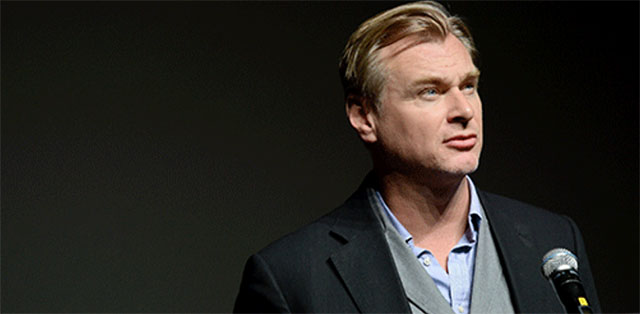
Oppenheimer is the new movie from the masterful Christopher Nolan and it arrives at Cineworld this July. An all-star cast puts a human face on this epic drama, which recounts the birth of the atomic bomb and the advent of a new age in human history when the noble intentions of one man were thwarted and twisted into something else entirely.
Cillian Murphy plays the eponymous scientist J. Robert Oppenheimer and the outstanding supporting cast includes Emily Blunt, Matt Damon, Florence Pugh and Robert Downey Jr. The film is painted on a typically epic and serious-minded scale with IMAX-camera-lensed vistas and a characteristic focus on practical, in-camera effects as opposed to CGI. No director other than Nolan would attempt to recreate the real-life atomic 'Trinity Test' but that's what he's undertaken for the movie.
It's another hallmark of Nolan's singular and engrossing vision. In the 23 years that he's been making movies, Nolan has been known to break several rules of moviemaking in often surprising and enthralling ways.
Here's our blog rundown of Nolan's 10 most incredible risk-taking moments. These are what have cemented him as one of the most successful and brilliant filmmakers of our time.
1. He destroyed linear storytelling with Memento
Here was the film that put Nolan on the map: a tricksy psychological puzzle that plays out across two timelines. Guy Pearce is superb as the short-term memory sufferer on the hunt for his wife's killer, and his condition informs the very fabric of the movie. When one scene plays out, we then jump backward in increments, the cumulative effect of which challenges us to remember everything that's come before.
At the same time, black-and-white flashbacks play out in a more conventional forward-developing structure. At some point, we know the two timelines are going to intersect, but this isn't a gimmicky attempt to dress up the standard neo-noir thriller. Instead, Nolan (who adapts his brother Jonathan's short story) plays on the melancholy and alienation felt by Pearce's character, which is only amplified by the shocking conclusion.
All of Nolan's hallmarks were cemented here, primarily the non-linear storytelling, serious tone and the ability to elicit fine performances from actors. Memento was Oscar-nominated for its screenplay and grossed $39 million against a $4 million budget. In its own way, the movie anticipated the enormous fiscal and artistic success that would greet Nolan later down his career path.
2. He redefined Robin Williams in Insomnia
There's an intriguing tendency for comedians to go serious, whether it's Jim Carrey in Eternal Sunshine of the Spotless Mind, or Adam Sandler in Uncut Gems. However, few comic transformations are as startling as that of Robin Williams in Insomnia, Nolan's remake of a 1997 Norwegian movie.
Of course, the success of any performance has to be equally attributed to the director. Williams and Nolan were clearly simpatico in their construction of a devious serial killer, who torments Al Pacino's tortured cop in a distant Alaskan town. Nolan has always been a fine director of actors, and it's fascinating watching the subtlety of Williams' portrayal, never lip-smacking or cackling but steadily goading Pacino on.
The critical success of Insomnia would help set Nolan on the path toward the later Batman movies. And in turning Robin Williams from a comic actor with occasional serious leanings (Good Will Hunting) into a genuinely creepy figure of fear, Nolan also proved that he was an excellent collaborator.
3. He re-imagined Batman as a crime saga in the Dark Knight trilogy
The Batman franchise was in a bad way before Christopher Nolan redesigned it. Prior to 2005's triumphant Batman Begins, the most recent movie had been Joel Schumacher's critically panned Batman & Robin. Nolan had an uphill mountain to climb to restore any sense of dignity to the comic book icon.
But there was a reason why he was entrusted with the task. Both Memento and Insomnia (and his debut feature Following) demonstrated that Nolan had an excellent handle on both character and atmosphere. Here was a rare director who could look beyond the costume into the psychology of the character himself, akin to the celebrated graphic novel iterations of Frank Miller.
Batman Begins, on its debut, was widely hailed as the best movie to ever feature the character, and it was also a huge commercial success, empowering Nolan to continue the story. In 2008, The Dark Knight was described by Rolling Stone's Pete Travers as "bringing pop escapism whisper-close to enduring art". In other words, this was a superhero movie taking on the guise of something far more radical, a gritty crime epic that reimagines Gotham City as a utilitarian metropolis seething with corruption.
Of course, one has to mention Nolan and his brother Jonathan's reconfiguration of the Joker as an anarchic 21st-century terrorist. As embodied by the late, Oscar-winning Heath Ledger, the scarily plausible Joker embodies the grounded, somewhat realistic philosophy of Nolan's vision. And if things did get somewhat more overblown in The Dark Knight Rises, it was nevertheless a satisfying cap to the greatest comic book reinvention of our times, grossing more than $1 billion worldwide.
4. The Prestige is a magic trick in cinematic form
It takes great skill to fool an audience without cheating. That's the essence of any great magician, and it's a philosophy Nolan takes to heart in the 2006 movie The Prestige, adapted from Christopher Priest's novel.
The film is set in the 19th century and focuses on the escalating battle between warring magicians Angier (Hugh Jackman) and Borden (Christian Bale). The conflict takes a significant physical and emotional toll over the years, culminating in a series of revelations that are as horrific as they are jaw-droppingly clever.
The Prestige mirrors the classic three-act trick structure. As Michael Caine's Cutter explains in the opening narration, a traditional trick follows the pledge (the reveal), the turn (the twist), and the prestige (the final reveal). Nolan's diabolically clever film operates on these lines, unspooling flashbacks within flashbacks and multiple character deceptions to hoodwink us as to what's happening.
As Cutter says, in any magic trick, "You don't want to work it out... You want to be fooled". Such is the brilliance of The Prestige that the revelation is right there in front of us from the beginning; however, it's our refusal to acknowledge the truth that plays longest in the mind. The Prestige, therefore, not only mimics the structure of the magic trick but also the emotional response to them. It's a fabulous turn of events that adds emotional resonance to an eerie Victorian thriller.
5. Inception restored intelligence to the summer blockbuster
Too often, we're bamboozled with explosions and sound effects in blockbuster movies. Nolan, however, is able to embrace the tropes of popcorn entertainment while also daring us to dream a little bigger. In short, he's not just out to create a sense of awe, but a sense of thoughtful reflectiveness about our place in the world.
It was the 2010 epic Inception that cemented Nolan's success in bringing brainy concepts to a mass audience. The Dark Knight films (later to be concluded in 2012's The Dark Knight Rises) had an advantage in that they were built on a recognisable comic book character with existing mass appeal. Inception, however, was entirely Nolan's brainchild, a project he was able to make after Batman Begins and The Dark Knight reaped significant rewards for distributor Warner Bros.
The movie was an enormous gamble: a mega-budget, intricately constructed story of a mind heist. It's also a rumination on the power of dreams, and how the division between the sleep state and the real world is often perilously thin. The movie descends down a labyrinth of consciousness layers, each unfolding at a different rate relative to the one above it.
The concept is unashamedly head-scratching, yet Nolan pulled it off, aided by a starry cast. Led by Leonardo DiCaprio, Inception proved that when you put a complicated conceit in the hands of a master director, audiences won't necessarily be turned away. Instead, there's every chance they'll be thrilled and inspired, before later returning for more.
6. Interstellar brought quantum physics into mainstream entertainment
Very often, particularly in science-fiction movies, characters throw away complex concepts in offhand dialogue. The assumption, perhaps not unfounded, is that audiences will be bored or baffled by what's being said, and it's more important to keep the narrative chugging along.
Nolan, however, actively built the complicated mechanics of quantum physics into his 2014 blockbuster Interstellar. More than that, he consulted with physicist Kip Thorne on the development of the screenplay itself, to ensure that the premise resonated with a degree of authenticity. Thorne was also enlisted to render the most accurate depiction of a black hole so far seen on screen.
It's another sign of how Nolan trusts the audience to keep up, even if Interstellar's central wormhole explanation is stolen wholesale from 1997's Event Horizon. And it seems that quantum physics is more than capable of defying an intelligent director like Nolan. In his book 'The Science of Interstellar', Thorne is keen to point out that much of the movie is fantastical in concept, even if hard science helped drive the screenplay.
Nevertheless, not many contemporary directors would be brazen or ambitious enough to invest actual data into a sweeping outer-space odyssey. Such is Nolan's attention to detail, which also extends to elsewhere in the storyline – for example, the wave planet Miller, where one hour equates to seven years' worth of Earth time, later resulting in a video call that's heart-wrenching and revelatory.
7. Dunkirk brought multiple perspectives to the World War II drama
The World War II movie has been presented every which way, from the terrifying expressionism of Russia's Come and See (1985) to the raw, cinema-verite style of Saving Private Ryan (1998). Therefore, it takes a bold director to shake up those conventions and blow away the cobwebs of 70 years' worth of cinema, helping us to see the conflict with fresh eyes.
That's exactly what Nolan did with Dunkirk, a three-pronged examination of Allied survival and evacuation in and around Dunkirk in 1940. The film occupies land, sea and air across three different timelines, all of which are scrambled in Nolan's characteristic, non-linear style.
While Tom Hardy's fighter pilot Farrier spends an hour in the air strafing German bombers, the troops on the ground must suffer a week's worth of attacks whilst attempting evacuation. Meanwhile, the launch of the civilian vessels from England occupies a single day. The approach sends out a powerful message: heroism isn't measured empirically, but instead transcends all notions of time as we perceive it.
This is emphasised at the very end of the movie. As Fionn Whitehead's surviving soldier Tommy returns to the UK to read Winston Churchill's famous speech in the paper, we intercut with the stricken Farrier landing on the beaches of Dunkirk, where he's eventually captured by the Germans.
Chronologically, Farrier's capture happened earlier in the film, but the clever editing from the Oscar-winning Lee Smith makes it look like the event is happening concurrently. It's therefore apparent that Farrier's sacrifice has had a direct bearing on Tommy's liberation, and that of the other troops.
No mere gimmick, Dunkirk is instead a deeply compassionate and humane film that uses cinematic language to break down barriers between those on all sides of a global conflict. The innovation of Nolan's approach saw Dunkirk awarded with grosses of more than $500 million at the box office, allaying concerns that an experimental WWII film wouldn't reach a mass audience. Nolan also received his first-ever Oscar nomination for Best Director, ensuring the movie's artistic success.
8. He turned secretive marketing into an art form
We're used to movie trailers routinely giving away too much information. Nolan, however, has weaponised the withholding of details, turning secrecy into art, and sending the internet abuzz with speculation.
This arguably took shape for the first time with 2008's The Dark Knight. In the build-up to the film's release, speculation was growing as to Heath Ledger's interpretation of the Joker, something that was further stoked when he tragically died in January 2008.
All we'd had prior to Ledger's death was a tantalising shot of Nolan filming him, the actor obscured behind opaque glass. This was later followed by an extreme close-up of the actor in his full get-up, replete with a horrible rictus grin and cracked make-up. The eventual trailer gave us fragments, but only fragments, of his performance, including that famous Jimmy Stewart-gone-to-seed voice. It was both revealing and highly mysterious, allowing us a glimpse of the visuals without any sense of the context.
The hype continued to grow with the famous viral marketing campaign, reinforcing the mystique of the film's villain ('Why So Serious?') while also drawing Aaron Eckhart's Harvey Dent into the fold. Based on the history of the comics, we were expecting Dent to transform into Two-Face, but details of the transformation and visual conception were withheld. Instead, the marketing emphasised the 'vote for Harvey Dent' angle, building a profound sense of the film's white knight saviour without any of us having seen it.
It proved so successful that audiences were ravenous for the end result come July 2008. The Dark Knight went on to gross more than $1 billion worldwide and won a posthumous Oscar for Ledger. Emboldened, Nolan would later turn secrecy to his advantage on later productions Inception, Interstellar and Dunkirk.
9. He advocates celluloid in an era of digital
Nolan is not only a passionate advocate of the big screen experience, but he also champions the history of cinema. In an era where filmmakers like Steven Soderbergh are turning digital (in Soderbergh's case, even shooting movies like Unsane on iPhones), Nolan retains an analog sensibility.
He primarily achieves this through his passionate defence of shooting on celluloid. He recognises the format as the lifeblood of cinema and has joined fellow directors such as Martin Scorsese and Quentin Tarantino in preserving the medium. Nolan's films Dunkirk and Interstellar have variously been captured on IMAX 70mm and 35mm, bridging the early days of cinema with his progressive, trendsetting stories.
"To me, film is a medium that I love and it isn't just me, but a whole lot of other filmmakers who love shooting on film," Nolan told The Huffington Post in 2018. "It's not about the past or anything, it's just a way of telling a story. We tried to make Dunkirk in a very ambitious way and experimented with a lot of structural techniques. So me being a traditionalist is a technical question, not an artistic one."
At the same time, Nolan is gracious enough to recognise that "people should use whatever tools possible to express themselves". Nevertheless, in an era where Hollywood increasingly threatens to lose sight of historical precedent, it's refreshing that such a maverick filmmaker as Nolan advocates tradition.
10. He's a director whose name ensures audience interest
There's a reason why Nolan was described as "a franchise unto himself" by The Hollywood Reporter. He's carved out a lucrative yet artistic niche as a filmmaker who can prioritise big-screen spectacle and intelligent storytelling all at the same time. For this reason, Nolan is able to get both the popcorn audience and also the more discerning viewer on board, resulting in films that rake in money at the box office while also attaining critical plaudits.
This is a reputation that Nolan has steadily and fastidiously built over the years. It's earned him astonishing amounts of creative freedom – as cited earlier, he was able to make Dunkirk in the manner of his choosing because the distributors believe in his artistic credibility and also his ability to bring in the big bucks.
Nolan is one of the few 21st-century filmmakers whose name alone can sell a movie. For this reason, Oppenheimer is generating a lot of interest: outside of the broad historical context, we know very little as to Nolan's treatment of the events. However, this sense of mystery is what makes the project so alluring to a mass audience, and when Nolan himself describes Oppenheimer as "a horror movie", it doesn't take much to get a mass audience interested.
Click the link below to get your tickets for Oppenheimer, opening at Cineworld on July 21st.
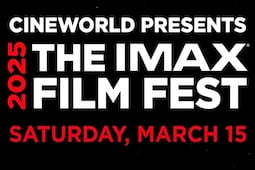


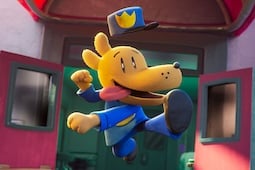



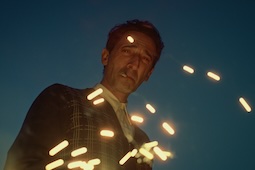

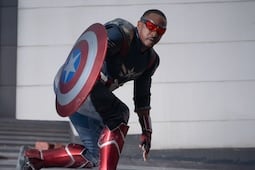




.jpg)
.png)






